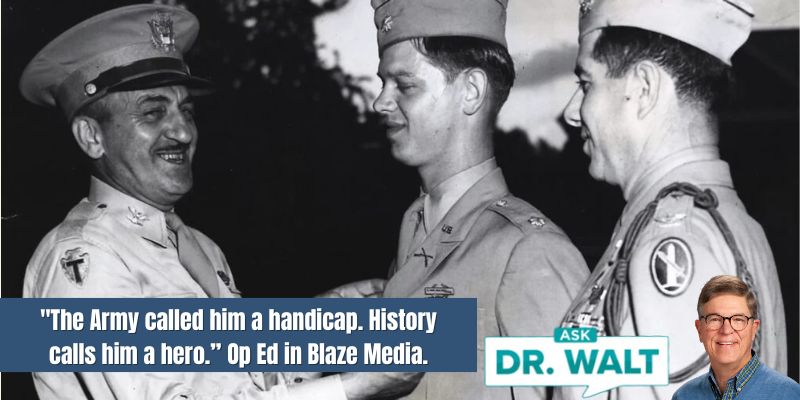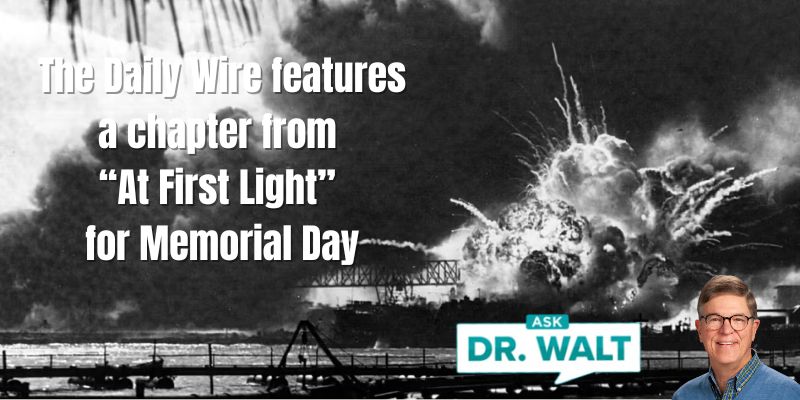
August 9, 1944 — Sailing for the southern France D-Day (Part 1)
August 9, 2024
August 11, 1944 — Sailing for the southern France D-Day (Part 3)
August 11, 2024August 10, 1944 — Sailing for the southern France D-Day (Part 2) – Phil & Ross see Churchill
After two days of sailing, on August 10, Phil and Ross Calvert were sharing a smoke on their ship’s afterdeck when they noticed a speck in the distance, distinguishable as some sort of craft, rapidly approaching. When the speedy launch drew closer, and the men could make out a boat with British markings and a Union Jack approaching their landing vessel, Phil and Ross stared unbelievingly. [1]

The short, stubby figure of Winston Churchill[2] stood on the deck. Doffing his famous black bowler caused his thinning white hair to be blown askew by the wind. They couldn’t believe their eyes. As the launch drew abreast, Churchill waved. Then the doughty little warrior flashed his equally famous V-for-Victory sign—the symbol of hope and determination—with two fingers on his right hand. The American soldiers cheered and waved back.
Phil could barely contain his excitement. “That’s Winston Churchill!” he exclaimed. “Wait until I write home ’bout this!”
“Remember, you can’t,” his buddy reminded him. “Not just yet.”
Phil shrugged. “I suppose you’re right.”
But now, he had another vivid memory to file away and tell his kids someday. That’s if he lived to have children.
On that score, Phil knew there was a lot more war left to fight.[1]
~~~~~
When, with the invasion convoy in mid-journey, it was announced that the destination was Southern France, the pattern was now complete. Africa, Sicily, Italy, Anzio … it had taken the 3d Infantry a long time to get there.
While the amphibious operation against the Riveria coast was to be ther fourth major landing against a hostile shore by the 3d Infantry Division, and the sixth for the 2d Battalion, 30th Infantry, the operation was by no means a purely routine performance. There were several important ways in which it differed from past operations.
In the past, certain elements of surprise had been mamjor features of the success of our landings. … The enemy could reasonably assume that we had employed all our major new tricks in the all-important Normandy invasion and had no surprises in store. In that event we had to depend solely on the surprises of time and place.
For the first time in its experience, the Division was faced with a daylight landing. This called for changes in many of the plans which had previously been successfully employed in night landings.
There was clear evidence that the enemy had constructed offshore obstacles along the Division’s beaches, which had never been encountered on any previous operation.
The tremendous concentration of shipping in the Naples area preceding our attack, and the shifting of the bulk of our strength to Corsica, combined with the limited area of coast upon which we were likely to land, minimized our chance for obtaining surprise. Added to this problem was the tremendous difficulty of maintaining security on the Italian mainland, where the majority of the planning and mounting was done.
All these factors, weighed together, meant only one thing—that we could not depend on surprising the enemy with small, scattered landings, but would have to plan on stunning him with all the firepower and concentrated mass of men and material that we could direct against a small number of close grouped beaches. The naval gunfire and air support plans were coordinated with the Division’s own attack plan to achieve this effect, but this in turn fitted into the Corps scheme to maneuver, which contemplated putting more infantry battalions ashore at H-hour than were put ashore in the Normandy landing.[3]
~~~~~
The Seventh Army, under General Patch, had been formed to carry out the attack. It consisted of seven French and three U.S. divisions, together with a mixed American and British airborne division. The three American divisions comprised General Truscott’s VIth Corps, which had formed an important part of General Clark’s Fifth Army in Italy. In addition, up to four French divisions and a considerable part of the Allied air forces were withdrawn from Alexander’s command.
The new expedition was mounted from both Italy and North Africa, Naples, Taranto, Brindisi, and Oran being used as the chief loading-ports. Great preparations have been made throughout the year to convert Corsica into an advanced airbase and to use Ajacioas a staging-port for a landing craft proceeding to the assault from Italy.
Landing-craft restricted the first seaborne landing to three divisions, and the more experienced Americans led the van. Shore defences all along the coast were strong, but the enemy were weak in numbers and some were of poor quality. In June there have been fourteen German divisions in southern France, but four of these were drawn away to the fighting in Normandy, and no more than ten remained to guard the 200 miles of coastline. Only three of these lay near the beaches on which we landed.
The enemy were also short of aircraft. Against our total of 5000 in the Mediterranean, of which 2000 were based in Corsica and Sardinia, they could muster a bare two hundred, and these were malt in the days before the invasion. In the midst of the Germans in southern France over 25,000 armed men of the Resistance were ready to revolt.
We had sent them their weapons, and, as in so many other parts of France, they have been organised by some of that devoted band of men and women trained in Britain for the purpose during the past three years.
The strength of the enemy’s defences demanded a heavy preliminary bombardment, which was provided from the air for the previous for the previous fortnight all along the coast, and, jointly with the Allied Navies, on the landing beaches immediately before our descent. No fewer than six battleships, twenty-one cruisers, and a hundred hundred destroyers took part.
The three U.S. divisions, with American and French commandos on their left, landed early on August 15 between Cannes and Hyères. Thanks to the bombardment, successful deception plans, continuous fighter cover, and good staff work, our casualties were relatively few. During the previous night the airborne division had dropped around Le Muy, and soon joined hands with the seaborne attack.[4]
~~~~~
[1] Larimore, At Frist Light, 118.
[2] Prime Minister Winston Churchill was traveling under the name of Colonel Kent, ostensibly on a fortnight’s bathing holiday in southern Italy. He had come to keep an eye on an enterprise he bitterly opposed, preferring to reinforce British and American forces in Italy and make amphibious assaults on the oil-producing regions in the Balkans. The decision to invade southern France churned up as much enmity within the Anglo-American alliance as any episode of the war. Nevertheless, Churchill was unable to resist seeing off the invasion convoy, and to wish Godspeed and a quick, successful victory to the United States troops. His visit was a favorable omen. He later wrote, “They did not know that if I had had my way, they would be sailing in a different direction. However, I was proud to wave at these gallant soldiers.”
[3] Taggart, 201-202.
[4] Churchill, The Second World War, 96., 98-99.
In case you haven’t read or listened to Dad’s book, you can learn more or order it here.
© Copyright WLL, INC. 2024.




